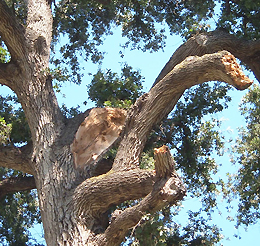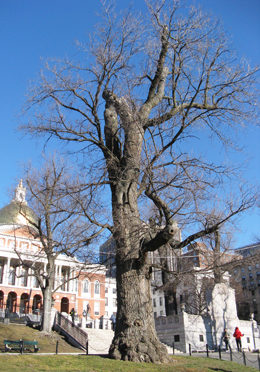Home > Pruning shade trees > Mature trees > Philosophy of reduction
Philosophy of reduction
 The objectives of reducing crown dimensions include clearance for buildings, street lights, or for view; reducing the risk of tree or branch failure (see ritght photo); reducing the amount of shade beneath a tree; mitigating broken branches when restoring following storms; or preserving old, historic, or weak mature trees. The entire crown may be reduced on trees that have become too large for the location or if the customer simply wants the tree shorter. Although it is possible to maintain a tree at a prescribed size with reduction, it is not always practical because it requires frequent pruning, sometimes annually. Reduced trees should usually be kept small in perpetuity; bonsai is an extreme example of reduction in perpetuity. Reduction is a balance between accomplishing objectives such as reducing failure potential and managing defects behind pruning cuts created by the treatment.
The objectives of reducing crown dimensions include clearance for buildings, street lights, or for view; reducing the risk of tree or branch failure (see ritght photo); reducing the amount of shade beneath a tree; mitigating broken branches when restoring following storms; or preserving old, historic, or weak mature trees. The entire crown may be reduced on trees that have become too large for the location or if the customer simply wants the tree shorter. Although it is possible to maintain a tree at a prescribed size with reduction, it is not always practical because it requires frequent pruning, sometimes annually. Reduced trees should usually be kept small in perpetuity; bonsai is an extreme example of reduction in perpetuity. Reduction is a balance between accomplishing objectives such as reducing failure potential and managing defects behind pruning cuts created by the treatment.
 Reduction should be applied only after considering the long term treatment, monitoring, and commitment associated with this method of pruning. Although trees have endured crown reduction throughout their lives having been reduced as they break in storms, reduction of the entire crown can lead to defects. With large pruning doses, these defects can include cracks and decay in pruned branches and dead bark on retained branches from sudden sun exposure; these defects can be very damaging to trees. The risk of damage from sudden sun exposure may be less in species with thicker, corky bark. For these reasons, it is best not to reduce the entire crown if at all possible, especially on mature trees. However, reduction can be a useful pruning method with many applications. For example, branches that extend beyond the main body of the crown (see photo at right) can be reduced to improve aesthetics or to lower the likelihood of breakage. Trees in exposed, windy locations can be reduced to lower the risk of breakage. Treatments such as cables, bracing or props can be combined with reduction to help trees remain intact and may be recommended depending on the particular tree condition and situation.
Reduction should be applied only after considering the long term treatment, monitoring, and commitment associated with this method of pruning. Although trees have endured crown reduction throughout their lives having been reduced as they break in storms, reduction of the entire crown can lead to defects. With large pruning doses, these defects can include cracks and decay in pruned branches and dead bark on retained branches from sudden sun exposure; these defects can be very damaging to trees. The risk of damage from sudden sun exposure may be less in species with thicker, corky bark. For these reasons, it is best not to reduce the entire crown if at all possible, especially on mature trees. However, reduction can be a useful pruning method with many applications. For example, branches that extend beyond the main body of the crown (see photo at right) can be reduced to improve aesthetics or to lower the likelihood of breakage. Trees in exposed, windy locations can be reduced to lower the risk of breakage. Treatments such as cables, bracing or props can be combined with reduction to help trees remain intact and may be recommended depending on the particular tree condition and situation.
Reducing the entire crown places physiological stress on a tree because many reduction cuts are required; reducing only portions of the crown causes less stress. Unlike a removal cut, reduction cuts remove the end portion of a branch back to a relatively-weak natural boundary. This results in some internal wood discoloration and can cause decay behind pruning cuts, especially in weakly compartmentalizing species, during drought, or for trees in poor health. Although reduction cuts made back to lateral branches that are at least one-third the diameter of the pruning cut are preferred when reducing crown size, heading cuts are sometimes necessary. Heading cuts are made back to a lateral branch smaller than about one-third the diameter of the pruning cut, or back to a bud point that lacks a lateral altogether. Preference should be given to cuts made back to a lateral branch, even if it is smaller than one-third the diameter of the cut.
 Crown reduction can be combined with thinning to meet objectives. For example, a high-valued or very old historic tree (photo at right) can sometimes be retained on a property in lieu of removing it by reducing mass farthest from the ground using reduction and removal cuts. However, it is easy to administer an excessive pruning dose when combining pruning methods, especially when applying them to the entire tree. Trees pruned in this manner become stressed because they lose storage capacity and access to energy reserves in the wood, can form cracks in wood, and may begin decaying internally while showing no outward signs. Hardwoods pruned in this manner typically sprout aggressively, quickly filling voids.
Crown reduction can be combined with thinning to meet objectives. For example, a high-valued or very old historic tree (photo at right) can sometimes be retained on a property in lieu of removing it by reducing mass farthest from the ground using reduction and removal cuts. However, it is easy to administer an excessive pruning dose when combining pruning methods, especially when applying them to the entire tree. Trees pruned in this manner become stressed because they lose storage capacity and access to energy reserves in the wood, can form cracks in wood, and may begin decaying internally while showing no outward signs. Hardwoods pruned in this manner typically sprout aggressively, quickly filling voids.
When appropriately executed, reduction cuts are made so that lateral branch tips remain intact on the outer edge of the new, smaller crown. Ideally, pruning cuts should be hidden and the crown periphery should look a bit jagged. Resist the temptation to create a smooth crown outline by pruning retained lateral branches because these are destined to become the main branches on the new, smaller crown. Do not remove interior and lower small branches along the main branches. If more than 25 or 30% of the foliage will be removed on anything but a young tree, consider dividing the job into two or more sessions at least one growing season apart to minimize energy removal and stress-induced sprouting.
Unfortunately, the trunk or large-diameter branches are sometimes pruned with heading cuts in order to bring a large tree to a desired size. This substandard practice is referred to by various names including topping, tipping, hat-racking, stag-heading, de-horning, lopping, or rounding over. It is not recommended because it damages trees permanently by compromising structure and health. Heading large-diameter branches can cause many problems including massive decay in numerous species, generation of sprouts, cracks in wood, and dead stubs. It occasionally kills trees. If a tree needs regular pruning to keep it small, the wrong tree was likely planted in that location. Consider replanting with an appropriately-sized plant or reducing it in perpetuity possible.
On most headed trees, sprouts quickly grow from latent (dormant) buds along the cut branches. Many sprouts emerge close to the pruning cuts; some emerge farther behind cuts. When sprouts with adjacent points of origin enlarge, they push against each other, sometimes resulting in bark inclusions and failure. Even if they do not touch, they are initially attached to the branch by only the most current growth increment generated after pruning. The new growth is often so dense that few lateral branches develop along the new sprouts. As a result, new sprouts are upright, poorly tapered, and weakly attached. They gain a better attachment with time.
The wood on the interior (i.e., the oldest wood) of topped branches can decay rapidly on some species, which increases the susceptibility of sprouts to failure as they grow in length and weight. Topped trees also regain their original height quickly, sometimes in a year or two, depending on the species, the severity of pruning, soil characteristics, and tree condition. Injury resulting from freezing temperature, storm damage, sudden branch failure, flooding, and severe drought can also have an effect similar to that of topping.

